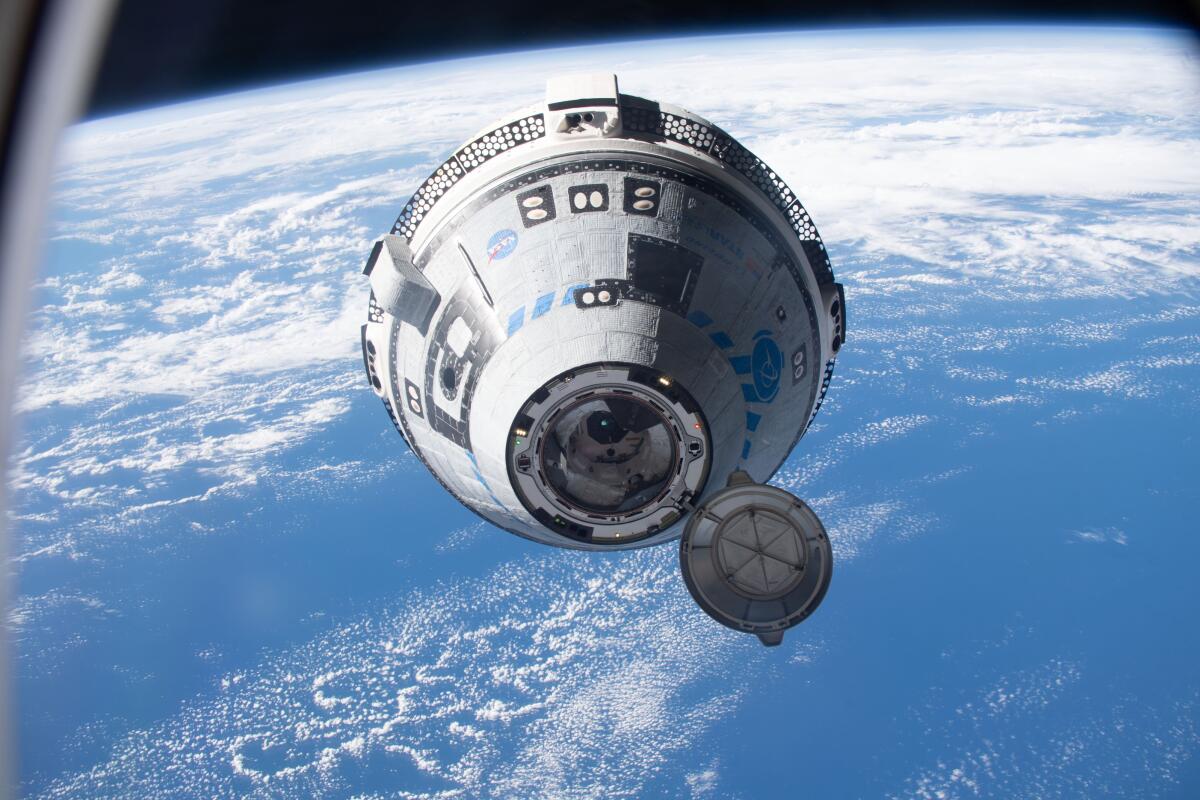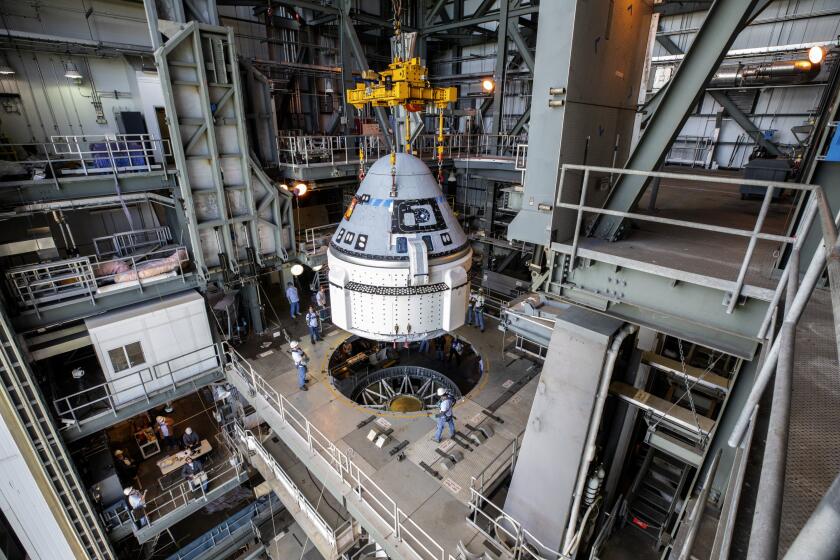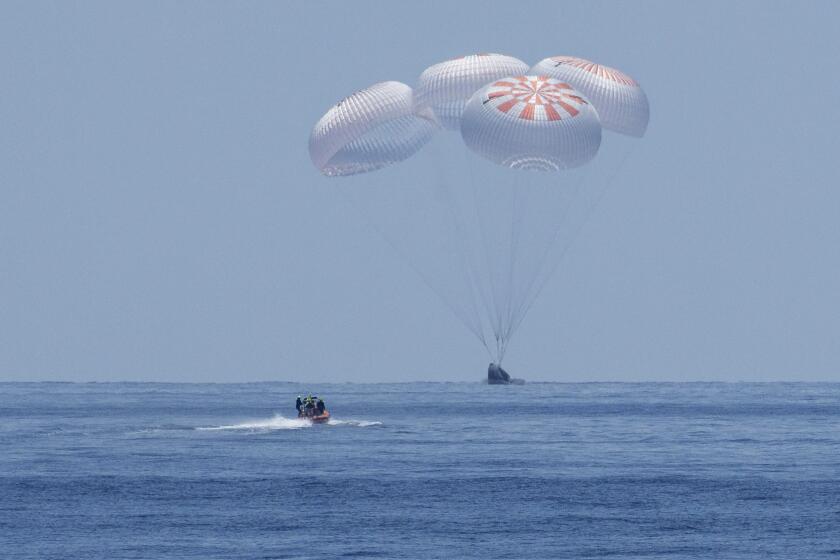Boeing sent two astronauts into space. Now NASA says it may need SpaceX to go get them

- Share via
NASA officials conceded Wednesday that the agency might have to rely on SpaceX to return two American astronauts to Earth from the International Space Station due to problems with Boeing’s Starliner spacecraft.
Astronauts Suni Williams and Butch Wilmore were launched on June 5 to the orbiting lab in the Starliner’s first manned trip to space after years of delays. What was expected to be a roughly one-week mission, however, has turned into an open-ended odyssey with the pair stuck on the station for two months as NASA and Boeing officials investigate malfunctions with Starliner’s propulsion system.
The Starliner may still be able to return the astronauts to Earth, but NASA officials said during a news conference that they are developing alternate plans that would have SpaceX’s Crew Dragon spacecraft bring them down. If SpaceX is needed to transport the astronauts, it is possible the return flight wouldn’t occur until February, meaning Wilmore and Williams would have to remain at the space station for six more months.
“Our prime option is to return Butch and Suni on Starliner. However, we have done the requisite planning to make sure we have other options open and so we have been working with SpaceX to ensure they are ready to respond,” said Steve Stich, program manager for NASA’s Commercial Crew Program.
The announcement by NASA is a blow to the troubled aerospace company, as Boeing grapples with an investigation into the cause of a door plug blowing out during a 737 Max 9 flight this year — as well as the continuing repercussions from the two crashes of its 737 Max 8 jets several years ago.
Boeing and SpaceX were given multibillion-dollar contracts in 2014 to develop spacecraft to transport crew and cargo to and from the orbiting space station after the ending of the Space Shuttle program, which forced NASA to rely on Russia’s Soyuz spacecraft to send American astronauts to the station.
Since then, Elon Musk’s Hawthorne company has ferried more than half a dozen crews to the station, whereas the current Starliner mission was its first crewed test flight.
Engineers said they identified problems with the Starliner capsule that have kept two astronauts at the International Space Station, but no return date to Earth is set.
Marco Caceres, an aerospace analyst at Teal Group, said the mission has become a debacle for Boeing as it grapples with Starliner’s myriad problems.
“They are three, four, five years behind SpaceX with this program. The only reason NASA really has been giving Boeing chance after chance after chance is because it really does want to have backup capability so that it never has to rely on the Russians,” he said.
Just last week, Boeing wrote off an additional $125 million in expenses related to the program after previously booking some $1.5 billion in cost overruns.
The June mission had been delayed for weeks after a helium leak in Starliner’s propulsion system was detected on the launch pad, but NASA gave approval for the launch after determining it did not pose a risk to the astronauts and would not prevent the capsule from reaching the space station.
On the ascent to the station, however, the helium leak worsened, and during docking the thrusters that propel the craft in space malfunctioned. NASA said last month that testing at its White Sands Test Facility in New Mexico found that Teflon seals that control the flow of fuel in a valve were one cause of the malfunction.
On Wednesday, officials provided additional detail, saying the seals had swelled during the ground testing, although a test of Starliner’s engines in space on July 11 indicated they were performing to specifications, indicating the Teflon had returned to its original form.
NASA officials have said that Starliner has 10 times more helium than it needs to return Starliner to Earth. The gas is used to pressurize the craft’s propulsion system. But Stich said Wednesday that engineers were analyzing the possibility that on a return flight there would be a simultaneous leak of the helium and a malfunctioning of the thrusters.
“The worst case would be some integrated failure,” Stich said.
He acknowledged there was disagreement over the safety of returning the astronauts on the Starliner.
Last week, Boeing issued a statement that cited all the testing that had been conducted and concluded, “Boeing remains confident in the Starliner spacecraft and its ability to return safely with crew.”
Boeing officials did not attend the news conference, unlike previous NASA updates on the Starliner mission. A decision on whether to return the astronauts on Starliner is expected to be made in the next few weeks, he said, with NASA Administrator Bill Nelson ultimately responsible for the call.
If the agency decides that it is too risky to return the astronauts aboard Starliner, it would bring them down on the next flight of SpaceX’s Crew Dragon capsule. That mission had been scheduled to blast off this month but has been delayed until no earlier than Sept. 24 to give the agency time to make its decision, he said.
SpaceX’s Dragon spacecraft will take a new route home next year after the company announced it will move its splashdowns to the waters off California.
Under that scenario, the Crew Dragon would blast off with two crew members and come back with Williams and Wilmore and two other astronauts when it returns sometime in February 2025. The Starliner, meanwhile, would remotely undock and return to Earth without a crew.
The first two test flights of the Starliner in 2019 and 2022 were conducted without a crew. Stich said that returning Starliner this time would only require that the control software be set for an uncrewed mission
More to Read
Inside the business of entertainment
The Wide Shot brings you news, analysis and insights on everything from streaming wars to production — and what it all means for the future.
You may occasionally receive promotional content from the Los Angeles Times.













